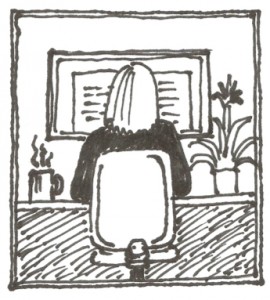 At an SfEP local group meeting the other day, someone asked the question “Do you read things more than once?” Several of us answered “No” without hesitation. Often, there is not the budget to allow for more than one full pass at the proofreading or copy-editing stage. However, as the conversation went on, that “no” was further qualified.
At an SfEP local group meeting the other day, someone asked the question “Do you read things more than once?” Several of us answered “No” without hesitation. Often, there is not the budget to allow for more than one full pass at the proofreading or copy-editing stage. However, as the conversation went on, that “no” was further qualified.
There’s no doubt that looking at something more than once is likely to provide a more accurate end result. So when, and in what ways, might it be appropriate to go over things again?
- A way to get a quick overview is to check the contents carefully first against the main body of the book or document when proofreading. Check that chapter names are correct and numbered correctly, and check the running heads. As well as ensuring that the contents list is accurate, this provides a quick overview of the book’s structure and general content, so you know what’s coming – this may influence early proofreading decisions, potentially saving you time and angst later on.
- One idea that was suggested was to make separate passes for different kinds of error – either those specific to the project, or errors we personally know we have a tendency to overlook. These weaknesses will vary from person to person; I know I have a blind spot when it comes to subheadings, for instance. Someone else mentioned en dashes in number ranges. There will be at least as many examples are there are editors.

- We also agreed that the need for multiple readings might be dictated by the subject matter or the genre of the project. Fiction, for example, demands an in-depth understanding of plot and structure that may not be possible to grasp with a single read. Of course structure is important in a non-fiction book too, but often it will be more explicit and prescribed.
- Some editors swear by printing things out and doing a separate read-through on hard copy. Again, the decision to do this, or not, will come down to personal preference and may well be influenced by the budget.
- Most of us probably use some kind of end-of-project checklist to help us scan the text for particular things at the end of a job. This might be a standard checklist that we use for every project, or something more specific to the job (perhaps provided by the client), or a combination of the two approaches.
- Finally, we all agreed that when starting out proofreading, multiple passes are probably necessary. Any proofread or edit involves looking for a range of types of error, and it takes time to learn to pick up all the little details, while also reading for meaning. Accuracy at speed comes with practice.
Do you read more than once? And do you do a detailed read, or do you have strategies to speed things up?
 Posted by Liz Jones, SfEP marketing and PR director.
Posted by Liz Jones, SfEP marketing and PR director.
The views expressed here do not necessarily reflect those of the SfEP.

I would never, ever read only once. I generally read three times, first reading for meaning and making obvious corrections along the way, then reading carefully again for structure, consistency, and things I might have overlooked in the first pass, then reading again to check my corrections and comments to ensure I’ve said what I meant to say. Occasionally, more is required. I am currently working on a memoir that requires a good deal of shuffling and reordering and I’m on my fifth pass. Undoubtedly there will be more as I work with the author to iron out wrinkles. I take the time and effort necessary to produce my best result; I cannot do otherwise. My sense of integrity and professional excellence will not allow me to do otherwise, even if I don’t get paid for all those hours. It’s not entirely about the money. By the way, I’ve been editing for some fifty years.
I take a different approach to Laura. I only do additional proofreading passes if the client and I have budgeted for them. Proofreading is my business, and my clients need to respect my professional integrity by acknowledging that my expertise has value, and therefore a price. I’m happy to report that an increasing number of my independent-author clients are recognising the benefit of multiple passes.
For quality-control purposes, I always break down the proofreading process into separate tasks so that I can focus on distinct issues. For example, checks for widows/orphans, correct running heads, page numbering, spelling, heading levels, and so on, all take place one at a time during each pass. That way, even if the client is only paying for one pass, I’m going through the content multiple times while I look for different problems.
Hi all
I’m with Louise on this. Although at the other end of the experience spectrum from her (I’ve only been at this a few months) I’ve naturally adopted a multi pass approach. I have a checklist that I work through a pass at a time (several of the passes being macro-assisted): spelling, quotes, hyphens, headings&layout, citations etc. only when I’ve completed all these do I do a full read for grammar and sense. This means I can do the latter undistracted by all the other issues.
Having said this, I do wonder if I’ll ever make a living doing it this way!
I note the comment that ability to do more things at once comes with practice, so maybe my approach will change; but the trade off will be the reduced ability to leverage the automation of Word in s single pass.
Chris
I’m with Chris on using macros to automate as many individual editing tasks as necessary, freeing my eyes and brain up for more unusual editing tasks. For instance, I always run a macro that replaces double spaces with a single on, replaces all quote marks and apostrophes to ensure they’re “smart,” and ensures dash consistency based on the correct style.
I always do two passes. The first is for proofreading or copyediting (whichever one I’m doing), and the second is—especially in copyediting—to ensure that the beginning details of the book mesh with what I now know is the ending. I also usually pick up a few missed things along the way…
Thanks for a great blog! 🙂
Here at work the “Copyediting and Proofreading Checklist” says, “In any event, read every job twice.” I always miss things in the first read. I also do separate checks to make sure, for example, that all parentheses and quotation marks are paired. These things are on the checklist too.
As a project editor I have a little more time than most because I see a project from start to finish and can fit readings in across a longer span of time. That said, I read first for initial copyedit. Then I print and read the first proofs after layout, because I prefer being able to scribble notes to myself and flip back and forth between pages/chapters (and because reading on the screen every time is hard on my eyes). Then I read again after all author/proofreader corrections have been made, either online or (preferably) on hard copy. Finally, after indexing I do a scan of the entire printed book for final check items before it goes to the printer.